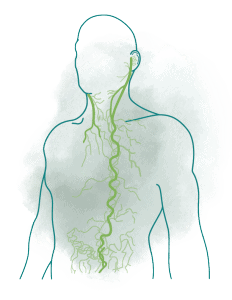The autonomic nervous system (ANS) influences many important functions in our body, such as the heart, respiration rate and digestion, and constantly sends signals to our body so we’re ready to react to any given situation.

Largely governing the ANS is the vagus nerve. The longest cranial nerve in our body, the vagus nerve stretches from the brainstem to the stomach, and according to Dr. Stephen Porges’ Polyvagal Theory is divided into the dorsal and ventral vagus. The dorsal vagus responds when we detect cues of extreme danger, while the ventral vagus responds to positive cues of safety, which is what allows us to be in a calm and regulated state. When threatened, our initial response is a withdrawal of the ventral vagus — this positions the sympathetics and dorsal vagus to become available for defense.
When we’re stuck in a state of chronic defense, it’s difficult to change our thoughts, feelings and behaviors. But if we can regulate our ANS, we can change the way we respond to life’s challenges, how we experience and engage in therapy, and how we connect to the world around us and others in it.
Stimulating the ventral vagus can help activate the social engagement system so that we can become more aware, regulated and resilient, and more receptive to therapeutic interventions.
Here are three ways you can help stimulate the vagus nerve.
Vocalization: Humming
Rhythmic vibrations from humming stimulate the vagus nerve and influence heart rate variability (HRV), a broad measure of overall health and fitness and a biomarker for homeostatic capacity as well as the potential for a healthy lifespan.
In unison or independently, hum a familiar tune. Notice the sensations in your head, throat and chest, and experiment with different volumes and physical qualities.

Discover the Safe and Sound Protocol
Developed by Dr. Stephen Porges, the SSP is a non-invasive acoustic vagus nerve stimulator that helps clients connect with themselves, others, and the world from a foundation of physiological safety.
Breathing: 4-part box breath
Voluntary rhythmic breathing activates the vagus and its associated nucleus in the brainstem responsible for regulating autonomic stress-reactivity. Follow along to this box breathing video to activate the vagus nerve by breathing with rhythm, pause and intention.
Movement: Releasing the neck
The vagus nerve runs behind the sternocleidomastoid muscle and in front of the scalenes, which tend to be two of the tightest muscles in the neck, and can cause irritation to the vagus nerve. Stretching out these muscles relieves pressure that may compromise vagus nerve function.
Start to decompress by rolling your shoulders up, back and down, and direct your gaze forward. Slowly begin tipping your right ear toward your right shoulder without turning your head.
Shift your attention to the left side of your neck. When you feel it fully lengthened, bring your eye gaze to the right and take four to six deep breaths while noticing the sensation in the left side of your neck.
Return your head and gaze to the starting position, and repeat on the left side.

Get our latest eBook for more!
Download a free sample of our eBook, Nervous System Regulating Activities, and have your clients try these exercises curated by experts from our provider community to support awareness, embodiment and resilience.



 © 2025 Unyte Health US Inc.
© 2025 Unyte Health US Inc.